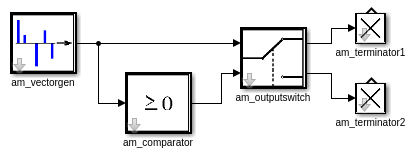Introduction
- PDEVS formalism:
- mathematical description of complex discrete systems
using components
- method and book (Zeigler et al.) widely popular
- but: not used in standard simulation
environments
- Basic obstacle for practical PDEVS use:
- uses Moore architecture (output depends on state,
not on input)
- Mealy only via transitory states
- → changes the expected order of concurrent
events
- → makes description complicated
- → behaviour of such components depends on
context
- serious drawback for a library of reusable
blocks
- Example compswitch:
- model
- idea
- negative/positive numbers leave through
upper/lower output
- behaviour in PDEVS
- comparator output only after internal switch to
transitory state
- input of outputswitch already on its way
- → some numbers use wrong output
- RPDEVS:
- "revised" PDEVS by Preyser et al.
- basic goal: make PDEVS fit for real-life
libraries
- allows for Mealy-like behaviour directly
- one generic state transition function
δ(s,e,x)
- output function λ(s, e, x)
- λ is always called before δ
- simulator changes the way chains of concurrent
events are handled
- Example singleserver:
- model

- push strategy = entities proceed as far as
possible
- queue has internal
state isBlocked
- server has output working
- server gets ready and queue holds several entities
- → complex cascade of concurrent events
- RPDEVS: model aborts ("too many λ steps")

